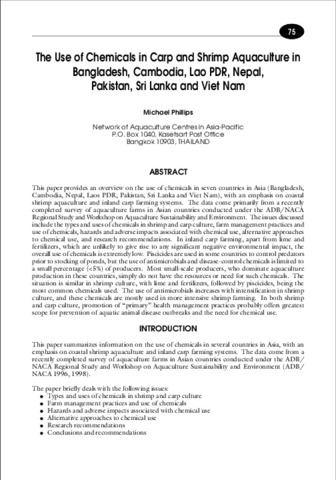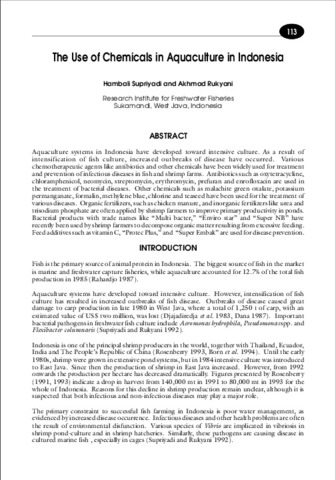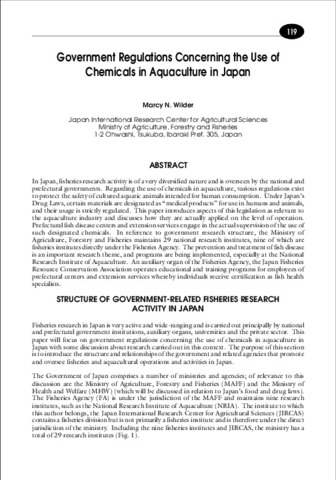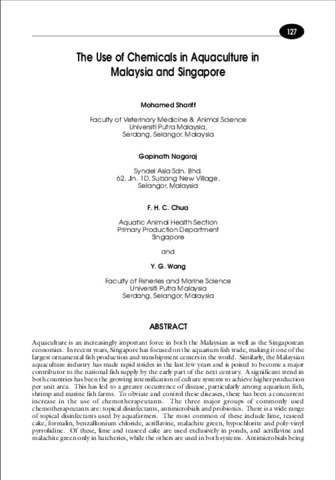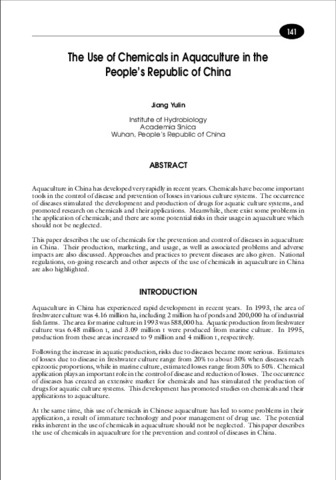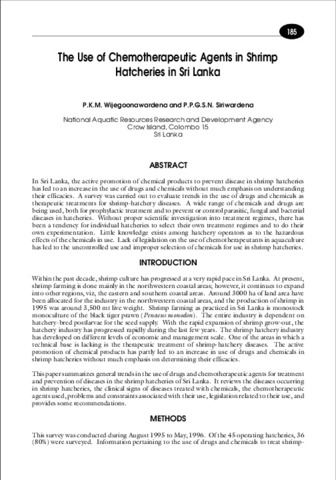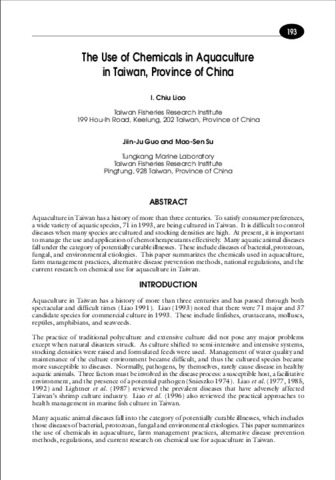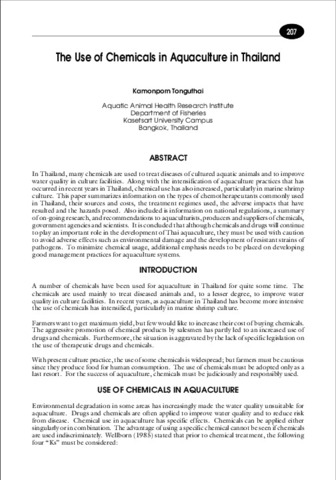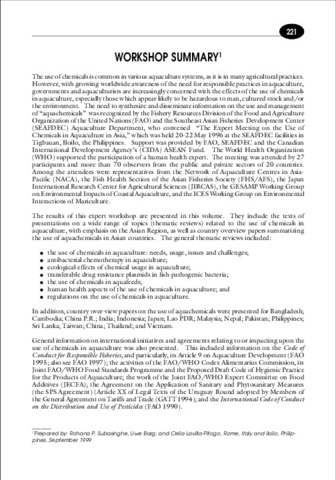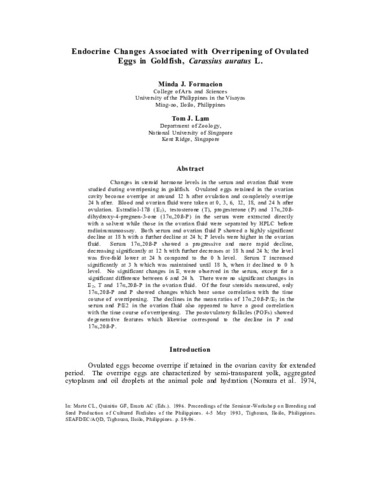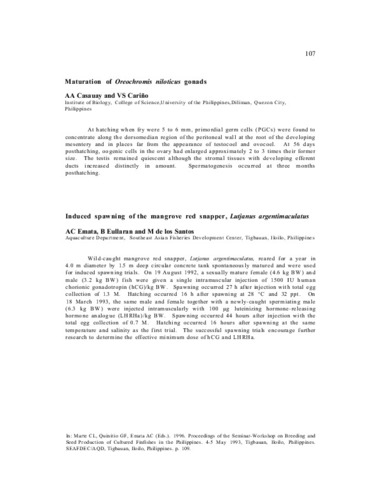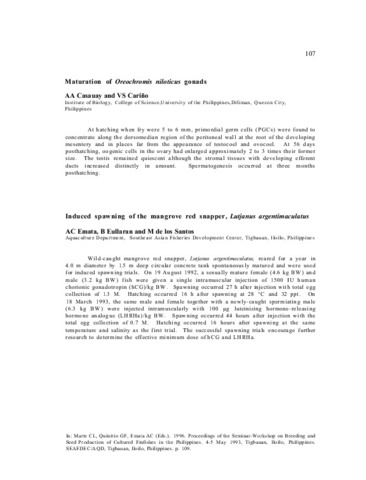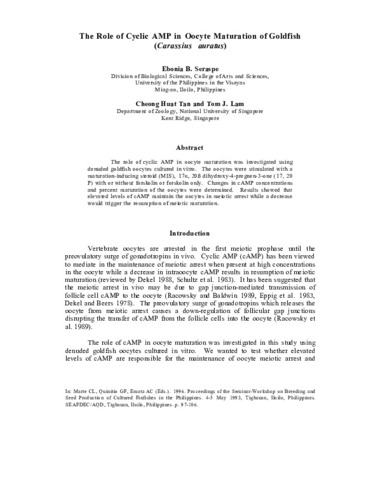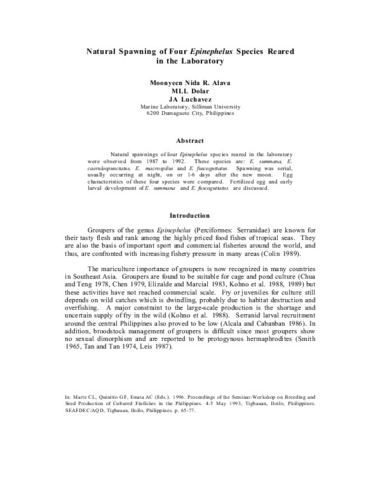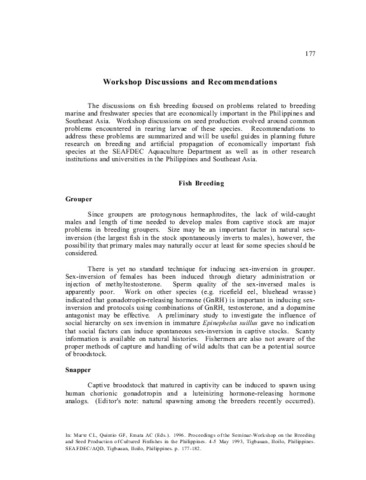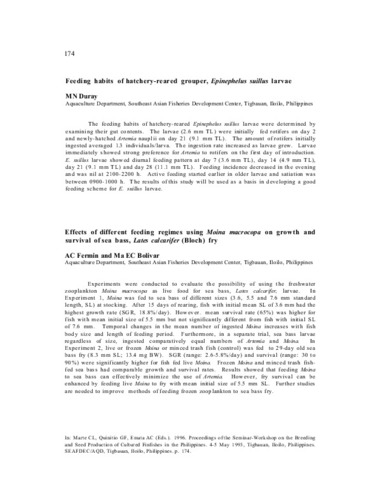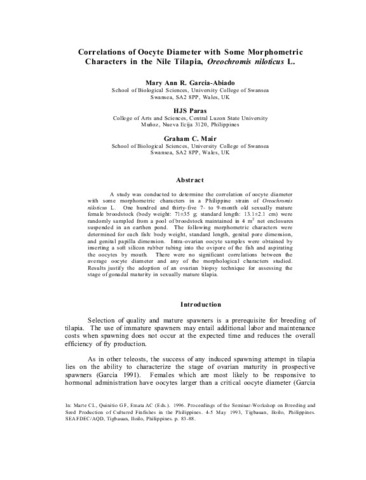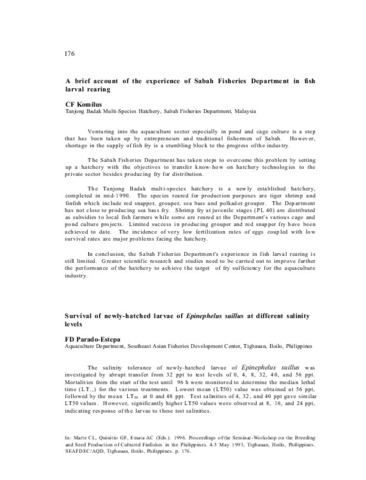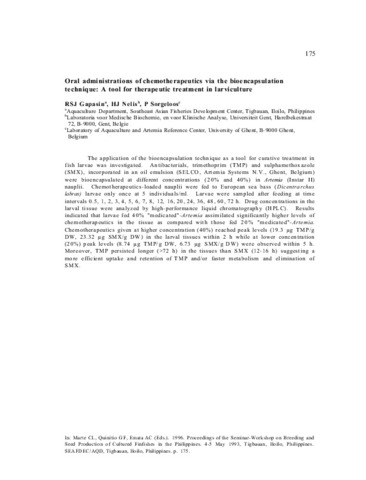Conference Proceedings: Recent submissions
Now showing items 561-580 of 767
-
The use of chemicals in carp and shrimp aquaculture in Bangladesh, Cambodia, Lao PDR, Nepal, Pakistan, Sri Lanka and Viet Nam
(Aquaculture Department, Southeast Asian Fisheries Development Center, 2000)This paper provides an overview on the use of chemicals in seven countries in Asia (Bangladesh, Cambodia, Nepal, Laos PDR, Pakistan, Sri Lanka and Viet Nam), with an emphasis on coastal shrimp aquaculture and inland carp ... -
The use of chemicals in aquaculture in India
(Aquaculture Department, Southeast Asian Fisheries Development Center, 2000)A review of the use of chemotherapeutants and other chemicals and drugs in Indian aquaculture is presented. A large number of products are used for various purposes such as soil and water treatments, disinfectants, piscicides, ... -
The use of chemicals in aquaculture in Indonesia
(Aquaculture Department, Southeast Asian Fisheries Development Center, 2000)Aquaculture systems in Indonesia have developed toward intensive culture. As a result of intensification of fish culture, increased outbreaks of disease have occurred. Various chemotherapeutic agents like antibiotics and ... -
Government regulations concerning the use of chemicals in aquaculture in Japan
(Aquaculture Department, Southeast Asian Fisheries Development Center, 2000)In Japan, fisheries research activity is of a very diversified nature and is overseen by the national and prefectural governments. Regarding the use of chemicals in aquaculture, various regulations exist to protect the ... -
The use of chemicals in aquaculture in Malaysia and Singapore
(Aquaculture Department, Southeast Asian Fisheries Development Center, 2000)Aquaculture is an increasingly important force in both the Malaysian as well as the Singaporean economies. In recent years, Singapore has focused on the aquarium fish trade, making it one of the largest ornamental fish ... -
The use of chemicals in aquaculture in the People's Republic of China
(Aquaculture Department, Southeast Asian Fisheries Development Center, 2000)Aquaculture in China has developed very rapidly in recent years. Chemicals have become important tools in the control of disease and prevention of losses in various culture systems. The occurrence of diseases stimulated ... -
The use of chemotherapeutic agents in shrimp hatcheries in Sri Lanka
(Aquaculture Department, Southeast Asian Fisheries Development Center, 2000)In Sri Lanka, the active promotion of chemical products to prevent disease in shrimp hatcheries has led to an increase in the use of drugs and chemicals without much emphasis on understanding their efficacies. A survey was ... -
The use of chemicals in aquaculture in Taiwan, Province of China
(Aquaculture Department, Southeast Asian Fisheries Development Center, 2000)Aquaculture in Taiwan has a history of more than three centuries. To satisfy consumer preferences, a wide variety of aquatic species, 71 in 1993, are being cultured in Taiwan. It is difficult to control diseases when many ... -
The use of chemicals in aquaculture in Thailand
(Aquaculture Department, Southeast Asian Fisheries Development Center, 2000)In Thailand, many chemicals are used to treat diseases of cultured aquatic animals and to improve water quality in culture facilities. Along with the intensification of aquaculture practices that has occurred in recent ... -
Workshop summary
(Aquaculture Department, Southeast Asian Fisheries Development Center, 2000)Prepared by Rohana P. Subasinghe, Uwe Barg, and Celia Lavilla-Pitogo, Rome, Italy and Iloilo, Philippines, September 1999. -
Endocrine changes associated with overripening of ovulated eggs in goldfish, Carassius auratus L.
(Aquaculture Department, Southeast Asian Fisheries Development Center, 1996)Changes in steroid hormone levels in the serum and ovarian fluid were studied during overripening in goldfish. Ovulated eggs retained in the ovarian cavity become overripe at around 12 h after ovulation and completely ... -
Maturation of Oreochromis niloticus gonads
(Aquaculture Department, Southeast Asian Fisheries Development Center, 1996)At hatching when fry were 5 to 6 mm, primordial germ cells (PGCs) were found to concentrate along the dorsomedian region of the peritoneal wall at the root of the developing mesentery and in places far from the appearance ... -
Induced spawning of the mangrove red snapper, Lutjanus argentimaculatus
(Aquaculture Department, Southeast Asian Fisheries Development Center, 1996)Wild-caught mangrove red snapper, Lutjanus argentimaculatus, reared for a year in 4.0 m diameter by 1.5 m deep circular concrete tank spontaneously matured and were used for induced spawning trials. On 19 August 1992, a ... -
The role of cyclic amp in oocyte maturation of goldfish, Carassius auratus
(Aquaculture Department, Southeast Asian Fisheries Development Center, 1996)The role of cyclic AMP in oocyte maturation was investigated using denuded goldfish oocytes cultured in vitro. The oocytes were stimulated with a maturation-inducing steroid (MIS), 17α, 20ß dihydroxy-4-pregnen-3-one (17, ... -
Natural spawning of four Epinephelus species in the laboratory
(Aquaculture Department, Southeast Asian Fisheries Development Center, 1996)Natural spawnings of four Epinephelus species reared in the laboratory were observed from 1987 to 1992. These species are: E. summana, E. caeruleopunctatus, E. macrospilus and E. fuscoguttatus. Spawning was serial, usually ... -
Workshop discussions and recommendations
(Aquaculture Department, Southeast Asian Fisheries Development Center, 1996) -
Feeding habits of hatchery-reared grouper, Epinephelus suillus larvae
(Aquaculture Department, Southeast Asian Fisheries Development Center, 1996)The feeding habits of hatchery-reared Epinephelus suillus larvae were determined by examining their gut contents. The larvae (2.6 mm TL) were initially fed rotifers on day 2 and newly-hatched Artemia nauplii on day 21 (9.1 ... -
Correlations of oocyte diameter with some morphometric characters in the nile tilapia, Oreochromis niloticus L.
(Aquaculture Department, Southeast Asian Fisheries Development Center, 1996)A study was conducted to determine the correlation of oocyte diameter with some morphometric characters in a Philippine strain of Oreochromis niloticus L. One hundred and thirty-five 7- to 9-month old sexually mature female ... -
A brief account of the experience of Sabah Fisheries Department in fish larval rearing
(Aquaculture Department, Southeast Asian Fisheries Development Center, 1996)Venturing into the aquaculture sector especially in pond and cage culture is a step that has been taken up by entrepreneurs and traditional fishermen of Sabah. However, shortage in the supply of fish fry is a stumbling ... -
Oral administrations of chemotherapeutics via the bioencapsulation technique: A tool for therapeutic treatment in larviculture
(Aquaculture Department, Southeast Asian Fisheries Development Center, 1996)The application of the bioencapsulation technique as a tool for curative treatment in fish larvae was investigated. Antibacterials, trimethoprim (TMP) and sulphamethoxazole (SMX), incorporated in an oil emulsion (SELCO, ...

